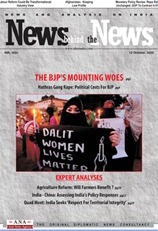India’s battle against COVID-19: Response efficiency has varied from state to state
The efficiency of response has varied across India. Kerala, Karnataka, Odisha, Andhra Pradesh, Rajasthan, Punjab, Haryana and the Northeastern states responded well, with strong public health measures combined with empathetic social services, writes Prof. K. Srinath Reddy for South Asia Monitor

The COVID-19 virus landed in India on January 30, 2020, along with a group of students returning from Wuhan, China to their homes in Kerala in southern India. It later wandered around North India’s golden triangle of Delhi, Agra, and Jaipur along with a group of Italian tourists who traveled to India in February just as the pandemic was beginning to ravage the Lombardy region of Italy. Since then, the virus has appeared across the country, with rising case counts and death toll. At mid-day of June 13, 2020, the case count of virus-positive persons stood at 309, 000 cases, with a death toll of 8,900. This places India in the top tier of virus affected countries. However, the absolute count does not take into account India’s population size.
Any international comparison must take into account the differences in the population size of the countries being compared. When the numbers are adjusted for the population count, India reveals a Cases Per Million (CPM) rate of 230 and Deaths Per Million (DPM) rate of 6.6. These are far less than seen in Europe or the US. Case count depends on testing rates which were low up to March but picked up later. However, COVID-19 death rates, across the whole population, provide a better assessment of both containment of spread as well as case management of diagnosed cases. Even if some deaths are underreported or misclassified, especially in case of out of hospital deaths, such underestimation could not have reduced the death count by more than half.
Even then, the DPM would compare very favourably with many European countries and the US where the DPM has ranged from well over 200 to even over 400. Just as per capita GDP matters more than overall GDP while comparing the economic status of countries, health and disease indicators need to be adjusted for population size.
Much of India yet unexposed to virus
The virus entered through the international airports of India and radiated from there. Eastern and Northeastern India were largely unaffected as such large airports were very few in those regions, other than in Kolkata. So the large cities and contiguous districts have been the most affected until recently. Though the virus has sprouted in several districts, like scattered weeds in a large field, much of the Indian population of 1.3 billion remains unexposed as yet. This is borne out by a recent sero-surveillance study of the IgG anti-COVID-19 antibody prevalence in randomly sampled populations in 64 districts of India. The evidence of previous COVID-19 infection was noted in only 0.73 percent of the population. The antibody was reportedly noted in 15-30 percent of the population samples obtained from the high intensity ‘containment’ zones of large cities, as reported in an as yet unconfirmed media report.
Even so, the prevalence rate of viral antibodies is likely to be very low in all of India. This, however, provides no room for complacency, as it indicates that the vast majority of the Indian population is as yet unexposed and vulnerable.
The experience of low population-adjusted mortality (DPM) is not unique to India. Other South Asian countries, as well as Southeast Asian countries, have uniformly experienced lower death rates than in Europe or the US, despite varying levels of economic development, socio-demographic features, and health system efficiencies. India’s low mortality rate is explained by the younger age profile and a large proportion (two-thirds) of the population being rural, with low mobility and limited exposure to foreign returned travelers. This may change to some extent if migrant workers who were confined in the cities during a long lockdown carry the virus back with them. Several states are quarantining them on arrival to prevent possible spread. Other proposed pathways of protection are hypothetical and await proof. They include non-specific potentiation of immunity from BCG or polio immunisation and a hot climate.
India’s response started with airport screening of incoming international travelers from mid-January and was scaled up to a nationwide lockdown from March 25. It was initially imposed for three weeks and then extended in three more stages up to June 8. The last two phases, after May 3, saw progressive relaxation in low-intensity zones. Containment zones in highly affected urban areas of large cities continue to have severe restrictions and intensive surveillance. Health services were ramped up during the lockdown, but large cities are now feeling the strain of rising numbers.
The initial assessment of high demand for ventilator-supported intensive has proven to be incorrect and scaled-down intensive care facilities, with assured oxygen supply, are being developed. Public sector services are playing a major role. The private healthcare sector is participating but some sections are attracting scrutiny and adverse comment for inappropriate or inaccurate testing, high costs of hospitalised care, and reluctance to admit sick COVID-19 patients.
States hold the key to checking COVID-19
The efficiency of response has varied across India. Kerala, Karnataka, Odisha, Andhra Pradesh, Rajasthan, Punjab, Haryana and the Northeastern states responded well, with strong public health measures combined with empathetic social services. Efficient contact tracing enhanced the value of strategic symptom guided and risk-stratified testing for case detection. Kerala and Odisha drew on the strength of elected local bodies (panchayats), while Andhra Pradesh deployed village and ward volunteers for symptom-based syndromic surveillance and contact tracing. Domestic manufacture of personal protection equipment, testing kits, and ventilators was ramped up as the government vowed to move India on to a path of self-reliance, after the jolt of supply chain disruptions in imports.
With much of India still unexposed to the virus, the need for continued public health measures (physical distancing, masks and hand hygiene) remains high, despite recent opening up in most states. Restrictions on large gatherings will continue. As India waits, with the rest of the world, for the virus to slow down or a vaccine to become available, India’s response moves now from a centrally directed operation to state-level planning and execution. Weaker health systems in the less affected states are yet to be challenged strongly by the virus. If it does so, will they take the lessons from the better performing states to mount a strong response? Only time will tell.
(The writer is President, Public Health Foundation of India (PHFI). He is a member of the Government of India Technical Taskforce for COVID-19. The views expressed are personal)

























Post a Comment